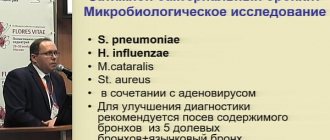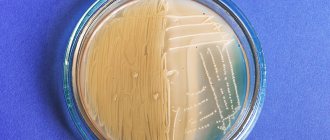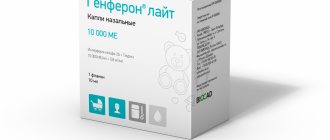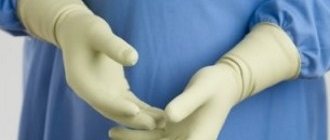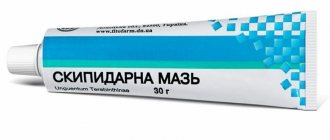A genus of bacteria belonging to the opportunistic microflora. Almost all people, including infants, are carriers of various streptococci. Normally, microbial activity suppresses the immune system. When its protection is weakened or a large infectious dose is received from the outside, streptococcal infections develop: inflammatory diseases that affect the mucous membranes of the respiratory tract, tissues of internal organs, teeth or membranes of the brain. Streptococci are very resistant to environmental factors and are capable of developing resistance to antibacterial drugs.
Detailed description of the study
The diagnostic method is cultural (bacteriological). Inoculation is carried out on a pathogen-specific - selective - dense medium with the addition of blood. After a few days, a quantitative and qualitative assessment is carried out: the fact of colony growth, the intensity of growth, a change in coloring - discoloration - of the differential diagnostic medium are noted.
Streptococcus pyogenes (β-hemolytic streptococcus group A or GABHS) is a round-shaped bacterium - the diameter does not exceed 1 micrometer - arranged in chains or pairs. Individual representatives of this group are capable of forming a capsule.
GABHS is one of the most common causes of acute pharyngitis and tonsillitis - inflammation of the pharynx and tonsils. According to modern data, in different age categories the incidence of ENT diseases caused by pyogenic streptococcus varies from 10-15% to 70%. Children aged 5-15 years are most susceptible to infection. In some cases, the microorganism is constantly detected in the microflora of the oropharynx and nasopharynx: in persons suffering from chronic tonsillopharyngitis.
The disease in its acute form occurs with characteristic symptoms:
- Sharp pain when swallowing;
- Redness and swelling of the mucous membrane;
- Enlarged submandibular and cervical lymph nodes;
- Purulent plaque of varying severity on the tonsils, the back wall of the pharynx;
- Increase in temperature to febrile levels (38.5 ° C) and above;
- Lethargy, lack of appetite, headache.
Three mechanisms are involved in the development of infection: infectious, toxic and allergic. There are rheumatogenic and nephritogenic strains of the pathogen. The former can provoke complications of acute tonsillopharyngitis in the form of damage to the joints and tissues of the heart, the latter - damage to kidney structures (glomerulonephritis).
The main cause of the disease is infection from a sick person, the route of infection is airborne droplets. The pathogen is transmitted with microparticles of saliva when sneezing or coughing. Also, the cause of an acute disease may be activation of streptococcus in bacteria carriers (with suppression of local immune defense factors). This usually occurs with general hypothermia, as well as as a consequence of a previous viral infection.
Streptococcus pyogenes is also capable of infecting the skin, causing the development of pyoderma. In this case, bubbles filled with cloudy contents appear on the surface of the skin, surrounded by an area of inflammation. Subsequently, they open, are replaced by crusts and fall off without the formation of defects. The disease is accompanied by general intoxication. The pathogen penetrates the skin when its integrity is violated (microtraumas, scratches, abrasions) or when local immunity is reduced. The risk group is people suffering from chronic diseases and young children.
The bacteriological, or cultural, method is the gold standard for diagnosing infections caused by GABHS (detection of streptococcal tonsillopharyngitis). The sensitivity—correct identification of patients—of the method exceeds 95%. Timely isolation of GABHS in a smear is essential for prescribing effective therapy, and also prevents the development of complications and, in most cases, the transition of the disease to a chronic form.
Diagnosis and treatment of streptococcal infections
Specific diagnosis of pathogens requires bacteriological analysis of scrapings of mucous membranes, samples of saliva, urine, sputum, purulent discharge and other biomaterials. In addition, blood testing for antibodies to streptococci is often necessary. Laboratory tests determine the type of pathogen within 20–30 minutes.
In addition to etiological tests for various pathologies, diagnosis of the general condition of organ damage is required: examination by an otolaryngologist, ultrasound, fluorography and some others.
Treatment tactics are selected taking into account the identified disorders and resistance of microbes to medications. Therapy is carried out by doctors of various profiles: gynecologists, therapists, pulmonologists, dermatologists. To suppress the activity of infectious microflora, patients are prescribed a course of antibiotics. Azithromycin, Erythromycin, and fluoroquinolone drugs are effective against streptococci: Ciprofloxacin, Levofloxacin. It is important to purchase and use medications as prescribed by a doctor. Self-indulgence in this matter leads to the development of superinfections. Therapy is also supplemented with immunomodulatory agents.
Sanitary measures, hardening, and the use of antiseptics help prevent the development of streptococcal diseases.
References
- Handbook of infectious diseases in children / ed. Yu.V. Lobzina - St. Petersburg. : SpetsLit, 2013. - 591 p.
- Kaspranskaya, G.R., Lopatin, A.S. Chronic tonsillitis: different views on an old problem. Medical Council, 2013. - No. 5-6. — P. 69-71.
- Finogeev, Yu.P., Pavlovich, D.A., Zakharenko, S.M. and others. Acute tonsillitis in infectious patients. Journal Infectology, 2011. - T. 3. - No. 4. - P. 84–91.
- Bakradze, M.D., Darmanyan, A.S. Differential diagnosis of acute bacterial and viral tonsillitis. Diagnostic algorithms in pediatrics, 2009. - T. 1, No. 2. — P. 56-61.
- Pokrovsky, V.I., Briko, N.I., Ryapis, L.A. Streptococci and streptococcosis. - M.: Geotar-media, 2008. - 540 p.
- Gieseker, KE Evaluating the American Academy Pediatrics diagnostic standard for Streptococcus pyogenes pharyngitis: Backup culture versus repeat rapid antigen testing. Pediatrics, 2003. -Vol. 111. - P. 66–70.
Treatment of streptococcus
In order to prevent the occurrence of all these terrible diseases, their causative agent, streptococcus, should be destroyed.
Treatment of streptococcus is carried out both medicinally (with the help of antibiotics and the zapping procedure) and prophylactically.
Treatment for streptococci can only be prescribed by a doctor. To identify streptococcus, you need to take a throat swab test.
It will also not hurt to take immunomodulatory drugs, which also have diuretic properties. Here is a small list of immunomodulatory agents for the treatment and prevention of streptococcal infections :
- raspberries;
- carrot;
- hops (infusion from cones);
- garden onion;
- garlic;
- series;
- Echinacea purpurea;
- Cherry juice;
- strawberry;
- burdock (vodka tincture);
- yarrow;
- walnut.
Causes
A person can become infected with streptococcus in the following ways:
- Airborne - when coughing, sneezing, screaming. The likelihood of infection increases during epidemics of colds. At this time, those who are forced to frequently stay in crowded places are at risk of becoming infected.
- Contact-household - in a room with a carrier of infection or a patient, in contact with common household objects. The likelihood of infection increases while staying in dusty rooms, since dust contains many tissue particles and, accordingly, pathogenic microorganisms.
- Sexual – unprotected sexual intercourse with a sick person or a carrier of infection primarily transmits group B streptococci, which provoke the development of genitourinary infections. Subsequently, the bacteria actively multiply in men in the urethra and in women in the vagina.
- Fecal-oral (alimentary) - occurs when a person does not follow the rules of personal hygiene.
- Medical – infection occurs when a doctor uses poorly disinfected medical instruments.
Since most often infection occurs through airborne droplets, children who live in large groups of children are very often infected.
Infants become infected due to infection of amniotic fluid and during passage through the birth canal.
The likelihood of developing purulent complications after infection with streptococci is influenced by a number of factors. Most often, complications develop in people with wounds and burns, in patients after surgical interventions, in pregnant women, and newborn children.
The following factors also increase the risk of infection:
- Chronic diseases, weakened immunity . Streptococcus often attacks a person against the background of hypothermia, colds, injury to mucous membranes, etc.
- Bad habits – drinking alcohol, smoking, taking drugs.
- Chronic fatigue, poor sleep.
- Poor nutrition leading to hypovitaminosis .
- Insufficiently active lifestyle.
- Uncontrolled use of medications ( antibiotics , vasoconstrictor drugs).
- Working and staying in contaminated areas without protective equipment.
General information
Streptococci belong to gram-positive chemoorganotrophic facultative anaerobic bacteria belonging to the Streptococcaceae family. They live in the mouth and nose, in the large intestine, in the digestive and respiratory tracts of humans and animals. In most cases, these bacteria are sensitive to penicillin .
They do not form spores. Streptococcal infection is a group of infectious diseases that are caused by different types of streptococci. They cause a very large number of diseases - from pharyngitis and tonsillitis to sepsis and endocarditis . The skin of the face, neck, hands, and respiratory organs are mainly affected.
Today there are more than 15 different types of streptococcus, but the most common of them are alpha, beta and gamma. And if alpha and gamma streptococci, not exceeding the normal amount, form part of the normal microflora of the gastrointestinal tract, oral cavity and respiratory system, then group B streptococcus is dangerous to health. It is the variety of these group B bacteria that causes the development of a large number of diseases.
This article will discuss which types of these bacteria are dangerous to humans and how to act correctly if a patient is diagnosed with a streptococcal infection.
Diet
Diet 13 table
- Efficacy: therapeutic effect after 4 days
- Time frame: no more than 2 weeks
- Cost of products: 1500-1600 rubles per week
During the treatment period, it is recommended to adhere to the principles of diet Table No. 13 . The diet should be light, the products should contain a large amount of vitamins. It is preferable to steam or boil dishes. Food should be taken in small portions - up to 6 times a day.
Proper drinking regime is also very important. It is recommended to consume up to two and a half liters of fluid per day, as drinking plenty of fluids helps remove toxins from the body. You should drink a lot of water, weak tea, a decoction of chamomile and rose hips, as well as drinks made from berries and fruits. In general, food should be varied.
During this period, it is recommended to exclude the following products from the menu:
- Spicy food.
- I'll bake it.
- Fatty soups and broths.
- Sausages and canned food.
- Strong coffee and tea.
- Alcohol.
Types of diseases
Streptococcal infection has various manifestations.
Streptococcus pyogenes may cause:
- tonsillitis;
- pharyngitis (inflammation of the pharynx);
- erysipelas (skin inflammation);
- impetigo (pustular skin lesions).
- osteomyelitis (purulent melting of bone);
- endocarditis (inflammation of the inner lining of the heart);
- meningitis (inflammation of the meninges);
- pneumonia (pneumonia);
- postpartum sepsis;
- rheumatism;
- scarlet fever;
- glomerulonephritis (kidney inflammation);
- boils and other diseases.
What else is prescribed with this study?
Microbiota analysis according to Osipov (biotope “Oral cavity, nasopharynx”)
199.12. Scraping, Smear, Scraping, Scraping, Scraping, Smear, Scraping 12 days
4 600 ₽ Add to cart
Sowing the discharge of the upper respiratory tract for microflora (nose, pharynx)
120.2. Scraping 4 days
690 ₽ Add to cart
Streptococcus gr.A (Streptococcus pyogenes), antigen test
162.0. Scraping 2 days
610 ₽ Add to cart
Streptococcus gr.B (Streptococcus agalactiae), antigen test
161.0. Scraping 2 days
620 ₽ Add to cart
